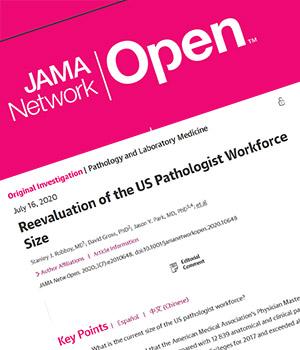
Robboy Discovers a 40% Undercount by National Agency of the US Pathology Workforce
In the July 16, 2020 issue of JAMA Network Open, Stanley Robboy, MD and his colleagues from the College of American Pathologists (CAP) report their discovery of a significant flaw in the methods how national entities count pathologists for workforce purposes. In “Re-evaluation of the US Pathologist Workforce Strength,” these flaws explain why the most recent workforce counts understate by about 40% the number of actively practicing pathologists there are in the US. The Association of American Medical Colleges (AAMC) database excludes from its count any pathologist who has received formal training in any of the various pathology subspecialties, such as cytopathology, dermatopathology, hematopathology, forensic pathology and eight others. This clarifies why the specialty of pathology has seemingly shrunk so during the past decade.
The AAMC does not provide data at the subspecialty level. It also is unaware that its data source, the AMA Physician Masterfile, replaces each pathologist’s initial designation as an anatomic and/or clinical pathologist when subspecialty training subsequently follows. Thus, if an anatomic/clinical pathologist receives later formal fellowship training in hematopathology, the physician’s primary specialty field is replaced with the subspecialty hematopathology and the AAMC removes the person from the pathologist count. As the percentage of residents taking additional training in a subspecialty (fellowship) has been rising, now documented at 97% of all residents, the AAMC database in reality is adding very few new entrants to the workforce annually. Instead it mirrors the retirement of older pathologists who were trained and practiced as generalists.
The accompanying invited editorial put perspective on the consequences of faulty counts. “Imagine that the 2020 US Census has been completed and the results show your state has lost 8% of its population [and thus lost] several congressional representatives, federal funding for hospitals and school lunch programs is reduced, and new businesses begin to pass over your state in favor of states that are expanding. Several years later, an audit is performed, and the previous census numbers were found to be incorrect; instead of having a decrease in population, your state actually had a substantial gain in the number of residents. However, by this point, the state has already experienced the consequences of the error.
Pathology has felt the effect on recruitment. Robboy and his associates call on all other previously published reports, presentations, and other uses of the data from the AAMC to be reexamined in this light. Indeed, the field of pathology is thriving and all new graduates are securing jobs.